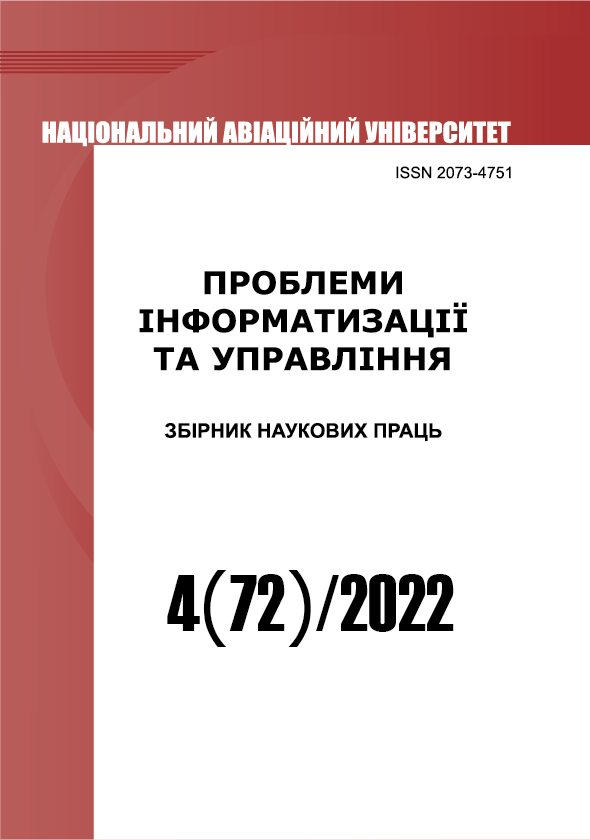Моделі топологій слабовипромінюючої телекомунікаційної системи взаємодіючих БПЛА
DOI:
https://doi.org/10.18372/2073-4751.72.17461Ключові слова:
комп’ютерна мережа, безпілотні літальні апарати, захищеність, багатокритеріальність, електромагнітне випромінювання, задача комівояжера, мінімальне зв’язувальне дерево, ІЕЕЕ 802.х, ITU Х.25Анотація
В опусі пропонуються нормативні моделі топологій телекомунікаційної системи взаємодіючих БПЛА, використання яких (моделей) дозволить визначати параметри топологій, що вони (опосередковано) підвищують ймовірність виконання безпілотними апаратами основної функції за рахунок мінімізації ймовірності демаскування рою БПЛА під час періоду взаємодії. При моделюванні введено припущення, що мінімізація ймовірності демаскування досягається виключно за рахунок мінімізації сумарної потужності каналоутворюючого прийомо-передаючого обладнання. Аналіз запропонованих моделей дозволить застосовувати відомі ресурсозберегаючі апаратно-програмні засоби (на кшталт описаних в рекомендаціях ІЕЕЕ 802.15.1, а також 802.3, 802.4, 802.5, ITU Х.25), придатні для застосування в розрахованих топологіях слабовипромінюючих телекомунікаційних системах взаємодіючих БПЛА. Виникаючу критеріальну невизначеність розв’язано класичним способом виособлення головного критерія, в якості якого вибрана мінімальна сумарна потужність каналоутворюючого прийомо-передаючого обладнання, з формуванням критеріальних обмежень. В якості контрольних значень рівня інтегрованості використано ступінь зв’язності зваженого графа, що моделює взаємозв’язок в бездротовій системі передачі даних. Введення ряду припущень дозволило використати класичні моделі задачі комівояжера та відшукання найкоротшого зв’язуючого дерева у зваженому графі, методи аналізу яких відшукано в класі цілочисельного програмування з додатковими логічнми умовами.
Посилання
Internetworking Technologies Handbook. – [Forth Edition]. – Cisco Systems, et. al. – Cisco Press, 2005. – 1040 p.
Жуков І.А., Печурін М.К., Кондратова Л.П., Печурін С.М. Розподіл ресурсів в обчислювальному кластері для БПЛА // Проблеми інформатизації та управління: зб. наук. праць. – 2016. – Вип.3 (55). – С. 34-38.
IEEE Standard for Information technology. Telecommunications and information exchange between systems. Local and metropolitan area networks. Specific requirements. Part 15.1: Wireless medium access control (MAC)and physical layer (PHY) specifications for wireless personal area networks (WPANs). IEEE Computer Society, 14 June 2005. URL: http://standards.ieee.org/getieee802/download/802.15.1-2005.pdf.
Roshan P., Leary J. 802.11 Wireless LAN Fundamentals. – M.: Publishing house "Williams", 2004. – 304 p.
Sineglazov V., Chumachenko O., Gorbatiuk V. Forecasting aircraft miles flown time series using a deep learning-based hybrid approach // Aviation. – 2018. – Issue 22. – No. 1. – P. 6-12.
Little J.D.C., Murrty K.G., Sweeney D.W., Karel C. An algorithm for the travelling salesmen problem // Operation Resoutce. – 1963. – Vol.11. – No. 6.
Чемерис О.А., Сушко С.В. Методи штучного інтелекту при оптимізації роботи мікропроцесорних систем // Комп’ютерні системи та мережні технології: тези доповідей ХІІ Міжнародної науково-практичної конференції CSNT-2019, Київ, 28–30 березня 2019 року. – К., 2019. – С. 127-129.
Taylor G., Burmeister R., Xu Z., Singh B., Patel A., Goldstein T. Training neural networks without gradients: A scalable admm approach. arXiv:1605.02026v1, 2016.
Боярінова Ю.Є., Воронін М.Г. Ефективний спосіб організації телекомунікацій в спеціалізованій комп’ютерній мережі рухомих об’єктів // Прикладна математика та комп‘ютинг: збірник тез доповідей XV наукової конференції молодих вчених ПМК-2022, Київ, 16-18 листопада 2022. – С. 209-213.
##submission.downloads##
Опубліковано
Номер
Розділ
Ліцензія
Автори, які публікуються у цьому журналі, погоджуються з наступними умовами:- Автори залишають за собою право на авторство своєї роботи та передають журналу право першої публікації цієї роботи на умовах ліцензії Creative Commons Attribution License, котра дозволяє іншим особам вільно розповсюджувати опубліковану роботу з обов'язковим посиланням на авторів оригінальної роботи та першу публікацію роботи у цьому журналі.
- Автори мають право укладати самостійні додаткові угоди щодо неексклюзивного розповсюдження роботи у тому вигляді, в якому вона була опублікована цим журналом (наприклад, розміщувати роботу в електронному сховищі установи або публікувати у складі монографії), за умови збереження посилання на першу публікацію роботи у цьому журналі.
- Політика журналу дозволяє і заохочує розміщення авторами в мережі Інтернет (наприклад, у сховищах установ або на особистих веб-сайтах) рукопису роботи, як до подання цього рукопису до редакції, так і під час його редакційного опрацювання, оскільки це сприяє виникненню продуктивної наукової дискусії та позитивно позначається на оперативності та динаміці цитування опублікованої роботи (див. The Effect of Open Access).


